There are several species of woodpecker in our region ranging in size from 17 cm to 42 cm. The ones most often seen around Nakusp are Downy Woodpecker, Hairy Woodpecker, Northern Flicker, Red-naped Sapsucker and Pileated Woodpecker.
The first two are very similar in appearance and can sometimes be difficult to distinguish. Both are essentially black and white with the males having a small red patch on the back of the head. Downy Woodpeckers, at about 17 cm in length, are a bit smaller than Hairy Woodpeckers, but the difference is slight and it is not always useful for identification.
The Northern Flicker is probably our most common woodpecker. Flickers are distinguished by the reddish-orange colour on the underside of the wing, plainly visible in flight. This is also the species that likes to drum on metal objects in the spring! Street lights, chimney covers and even metal roofs are often used. This drumming takes the place of singing and serves to declare “ownership” of the local territory.
Red-naped Sapsuckers are also fairly common, but tend to be less obvious than flickers. This is the only one of our woodpeckers that migrates; they arrive in early April and are gone by the end of September.
As the name suggests they feed on tree sap. They drill rows of small holes in the bark and return later when the sap has begun to run. They then eat the sap, as well as the insects that are attracted to it.
Like the Downy and Hairy, this is also a predominantly black and white bird. The sapsucker, however, has much more red on the head and also on the throat. The Pileated Woodpecker is by far our largest woodpecker at 42 cm in length. It is primarily black in colour with a prominent red crest and large white wing patches visible in flight. Because of the obvious red crest, this bird is often mistakenly called a ‘Red-headed Woodpecker’. The true Red-headed Woodpecker is found only in eastern North America.
Higher up the slopes of our valley there is another woodpecker that rarely ventures to the valley bottom. Unlike the previously mentioned species that are all some combination of black, white, and red, the American Three-toed Woodpecker is black, white and yellow.
At a glance, they look similar to the Hairy Woodpecker, but the clean white flanks and back of the Hairy are replaced by black and white barring in the Three-toed. And the red patch on the head of Hairy is replaced by a yellow patch.
Even in its preferred upland habitat, this is an easy species to miss; they are generally fairly quiet. They don’t call often nor is their tapping very loud. Rather than drilling holes through the bark in search of food, they just peel off flakes of bark. In recent years, this species has benefitted considerably from beetle-killed pine trees.
